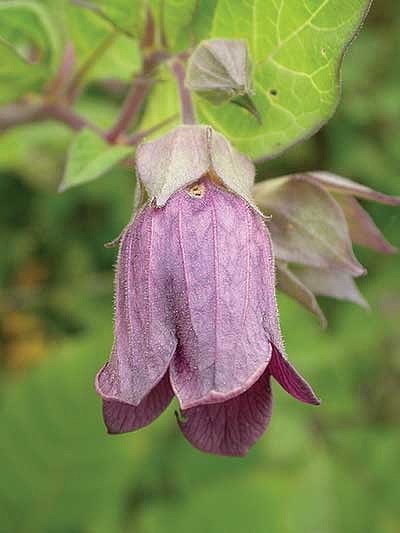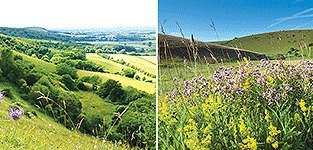Deadly nightshade! 'A poison bouquet to strike him down'
June 2nd, 2019 June 16th is Bloomsday, a celebration of the life of James Joyce, whose novel Ulysses follows Leopold Bloom’s escapades on that June date in 1904.
June 16th is Bloomsday, a celebration of the life of James Joyce, whose novel Ulysses follows Leopold Bloom’s escapades on that June date in 1904.June 16th is Bloomsday, a celebration of the life of James Joyce, whose novel Ulysses follows Leopold Bloom’s escapades on that June date in 1904. Throughout Ulysses, Joyce uses flowers to symbolize romance and the lure of the exotic. Aside from fornication Joyce also tackles expiration, hallucination and urination. All of which (well, apart from the urination) remind me of another bloom that will be raising hell around Sussex in June.
Deadly nightshade looks innocent enough. A tall plant with lush leaves and purple, bell-shaped flowers. Later in the year the glossy berries will catch your eye; dangling temptingly like black pearls. It’s in the plant family Solanaceae; related to potatoes and tomatoes. But deadly nightshade isn’t the sort of relative you’d invite round for dinner. And you certainly wouldn’t want it anywhere near the food. It is lethally poisonous.
Its name should be warning enough (and if not, colloquial nicknames such as ‘Satan’s Rhubarb’ and ‘Death Cherries’ underline the message). In 1597, Elizabethan physician John Gerard warned us ‘banish it from your gardens’ and steer well clear but we obviously weren’t paying attention. An internet search today reveals recent stories of accidental deaths, comatose children and a naked, hallucinating German monk.
It is reported (but possibly exaggerated) that just three berries will kill you. Symptoms start with a dry mouth, dizziness and urinary retention (ha – so there was a link to urination after all!) and progress to delirium, convulsions and a heartbeat so furious that it can be heard from several feet away. It’s all downhill from there. Incredibly, the berries are the safest part of the plant – you wouldn’t want to go anywhere near the roots.
Wicked witches would use the berries in a potion to make their broomsticks rise. Wicked women in Venice, looking for a similar reaction in their men, used deadly nightshade eye drops to dilate their pupils. The plant’s scientific name belladonna means ‘beautiful woman.’ The potential side effects of this beautification would later be the answer to the question ‘how do you make a Venetian blind?’
Barcombe botanist David Lang tells a tale of a student found staggering the streets drunk and disorderly. Nothing new there – until a police doctor saw his wide eyes and realised he had been poisoned by belladonna. He was rushed to hospital where it transpired that his landlady was trying to extract medicine from the berries and was straining them through the same strainer she was using to make his coffee each morning. You won’t get a kick like that in Costa. So, be cautious of this killer as you walk the Downs in June to ensure that your life, which to paraphrase Mr Joyce is already a ‘parenthesis of infinitesimal brevity’, is not made any briefer.
By Michael Blencowe: Learning & Engagement Officer,
Sussex Wildlife Trust
deadly nightshade flower©Graeme Lyons, Sussex Wildlife Trust
deadly nightshade©Graeme Lyons, Sussex Wildlife Trust
30 Days Wild
This June, join hundreds of thousands of people taking part in 30 Days Wild, the UK’s month-long nature campaign run by The Wildlife Trusts.
We’re challenging you to do something a little bit wild every
day in June – sign up now to receive your free pack of goodies to help plan your wild month:
www.wildlifetrusts.org/30DaysWild
Deadly nightshade looks innocent enough. A tall plant with lush leaves and purple, bell-shaped flowers. Later in the year the glossy berries will catch your eye; dangling temptingly like black pearls. It’s in the plant family Solanaceae; related to potatoes and tomatoes. But deadly nightshade isn’t the sort of relative you’d invite round for dinner. And you certainly wouldn’t want it anywhere near the food. It is lethally poisonous.
Its name should be warning enough (and if not, colloquial nicknames such as ‘Satan’s Rhubarb’ and ‘Death Cherries’ underline the message). In 1597, Elizabethan physician John Gerard warned us ‘banish it from your gardens’ and steer well clear but we obviously weren’t paying attention. An internet search today reveals recent stories of accidental deaths, comatose children and a naked, hallucinating German monk.
It is reported (but possibly exaggerated) that just three berries will kill you. Symptoms start with a dry mouth, dizziness and urinary retention (ha – so there was a link to urination after all!) and progress to delirium, convulsions and a heartbeat so furious that it can be heard from several feet away. It’s all downhill from there. Incredibly, the berries are the safest part of the plant – you wouldn’t want to go anywhere near the roots.
Wicked witches would use the berries in a potion to make their broomsticks rise. Wicked women in Venice, looking for a similar reaction in their men, used deadly nightshade eye drops to dilate their pupils. The plant’s scientific name belladonna means ‘beautiful woman.’ The potential side effects of this beautification would later be the answer to the question ‘how do you make a Venetian blind?’
Barcombe botanist David Lang tells a tale of a student found staggering the streets drunk and disorderly. Nothing new there – until a police doctor saw his wide eyes and realised he had been poisoned by belladonna. He was rushed to hospital where it transpired that his landlady was trying to extract medicine from the berries and was straining them through the same strainer she was using to make his coffee each morning. You won’t get a kick like that in Costa. So, be cautious of this killer as you walk the Downs in June to ensure that your life, which to paraphrase Mr Joyce is already a ‘parenthesis of infinitesimal brevity’, is not made any briefer.
By Michael Blencowe: Learning & Engagement Officer,
Sussex Wildlife Trust
deadly nightshade flower©Graeme Lyons, Sussex Wildlife Trust
deadly nightshade©Graeme Lyons, Sussex Wildlife Trust
30 Days Wild
This June, join hundreds of thousands of people taking part in 30 Days Wild, the UK’s month-long nature campaign run by The Wildlife Trusts.
We’re challenging you to do something a little bit wild every
day in June – sign up now to receive your free pack of goodies to help plan your wild month:
www.wildlifetrusts.org/30DaysWild
Comments (0)
No comments have been submitted yet.Why not be the first to send us your thoughts
Leave A Comment
Thank you for your comments, they will appear shortly once approved.
Recent Posts
Have You Seen...






